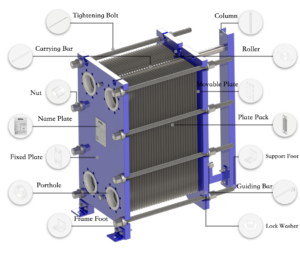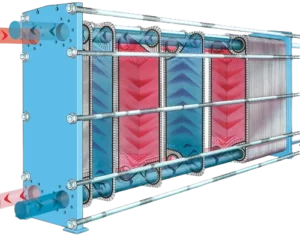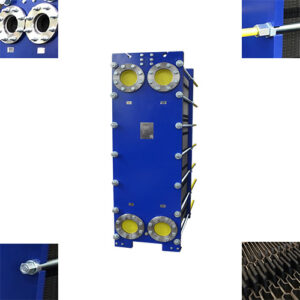- Home
- Plate Heat Exchanger
- Gasketed Plate and Frame Heat Exchangers

What is a Gasketed Plate Heat Exchanger and How Does It Work
What is a Gasketed Plate Heat Exchanger
Gasketed plate heat exchangers are efficient heat exchange devices formed by a series of corrugated thin metal sheets and gaskets. The hot and cold fluids between the plates are separated by sealing gaskets so that they flow independently in the flow channels on both sides.
The heat transfer coefficient of gasketed plate heat exchangers is 3-5 times higher than that of the shell and tube heat exchanger because the hot and cold fluids can reach a high degree of turbulence when they flow in the plate channels which have certain corrugated shapes on the plate surface.
How Does a Gasketed Plate Heat Exchanger Work
Gasketed plate heat exchangers are a type of heat exchanger that uses a series of thin metal plates with gaskets between them to transfer heat between two fluids. The two fluids flow through the heat exchanger in separate channels, with the hot fluid flowing through one set of channels and the cold fluid flowing through the other set of channels.
As the two fluids flow through the heat exchanger, heat is transferred from the hot fluid to the cold fluid through the thin metal plates. The gaskets between the plates help to create a seal between the two fluids, preventing them from mixing and allowing for efficient heat transfer.
The design of the gasketed plate heat exchangers allows for a large amount of heat transfer to occur in a relatively small space, making it a very efficient and compact heat exchanger. The heat transfer efficiency can also be improved by adjusting the flow rate, temperature, and other parameters of the fluids flowing through the heat exchanger.
Gasketed plate heat exchangers are commonly used in a variety of industrial and commercial applications, including HVAC systems, refrigeration, food processing, and chemical processing.
Gasketed Plate Heat Exchanger Structure
Gasketed plate heat exchanger is mainly composed of plates, sealing gaskets, fixed plates, movable plates, carrying bars, guiding bars, columns, support columns tightening bolts and nuts, frame feet, etc.
Advantages of Gasketed Plate Heat Exchanger
1) High heat exchange efficiency and low operating cost – Compared with shell-and-tube heat exchanger, its heat exchange effect is 3-5 times.
2) Compact design – Small footprint.
3) Easy to install – Occupying only 1/5 to 1/8 of the space required by shell-and-tube heat exchanger.
3) Convenient maintenance – Easy to disassemble and clean.
4) Convenient expansion – Open the heat exchanger to increase the number of plates.
5) The NTU value is large – The minimum temperature difference can be 1 degree.
6) Reliable – At HFM, we strictly adhere to the highest standards of quality and safety, ensuring all of our products meet the rigorous. requirements of GRG, FDA, and SGS certifications.

How To Assemble a Gasketed Plate and Frame Heat Exchanger

To assemble a gasketed plate heat exchanger, the following three steps should be followed:
1) The frames are put together. It consists of a fixed and moveable frame plate, top carryings bar, bottom guiding bars, tightening bolt, support column, and frame foot. The end plate is the first plate to be hung in the frame.
2) Then, the plate, according to the plate specification is placed between the frames, within the upper carrying bar and the lower guiding bar.
3) Lastly, the tightening bolts are installed to tighten the space between the fixed and movable frames using a spanner or a hydraulic wrench to a predetermined level depending on the model and number of plates of that plate heat exchanger.
The gasket plate heat exchanger (GPHE) utilizes corrugated plates located between the frame and pressure plates to provide an expansive heat transfer area. The gaskets act as seals between the plates, allowing for the counter-current flow of fluids through the exchanger, resulting in highly efficient thermal performance and a close temperature approach between the entering and exiting service mediums.
For heat-sensitive or viscous media, cold fluid is introduced to the hot fluid, reducing the risk of overheating or freezing. The plates come in various pressing depths, chevron-angled patterns, and corrugated shapes, all specifically designed to optimize performance based on the application.
The distribution area ensures even fluid flow across the entire heat transfer surface to avoid stagnant zones that may lead to fouling. High flow turbulence between plates results in enhanced heat transfer and pressure drop. HFM offers customizable thermal designs to suit a variety of applications and provide the greatest thermal performance with minimal pressure drop.
When selecting a GPHE, various advantages and disadvantages should be considered based on the specific type of exchanger required.
Basic Parameters of Gasketed Plate Heat Exchanger

Plate Materials:
Stainless Steel: 304L, 316L,904L
Special Metals: 254SMO, Hastelloy 276, Titanium, Nickel200/201
Gasket Materials:
NBR, NBR-HT, EPDM, EPDM-HT, Viton,CR
Test Parameters:
Design Pressure: Max 25bar
Design Temperature: -20~180℃
Recommended Applications of Gasketed Plate Heat Exchanger

